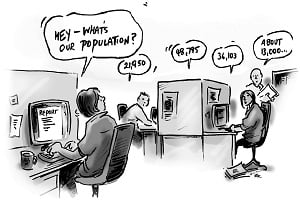With the Census results released yesterday, lots of people, organisations and governments are looking up their local area’s population using the Quickstats feature on the ABS website. The headline number on Quickstats is people, and many viewers take this to mean the official population. Believe it or not, these are not the same thing and this is leading to some confusion.

For example, this article in The Age, claims that in the 2011 Census Melbourne’s population came in at 3,999,982, well below the previous estimates of 4.14 million. This is not comparing apples with apples. The 3,999,982 figure is the 2011 usual resident Census count. It is being compared with the pre-Census 2011 Estimated Resident Population (ERP). These are not the same thing.
The Census count is a raw number which has not been adjusted to account for people who were missed in the Census and those overseas on Census night (and there were 475,000 Australians overseas on August 9th 2011). Once these adjustments have been made, they are published as the official population or the Estimated Resident Population. SoCensus counts are ALWAYS lower than the Estimated Resident Population. On average the Census count is around 4% lower than the ERP (although it differs between regions). The Melbourne 2011 Census-based ERP has not been published yet but if the adjustment is around 4%, then it’s likely to be pretty close to the estimated 4.14 million (although there are geography changes to take into account, but that’s a whole other issue!)
The ERP has been published for states and territories (and Australia total) – they came out on Wednesday, and we wrote a blog about them. But for smaller areas including cities and local government areas, the official population counts (ERP) won’t be out until July 31st (and we’ll be writing about that too). So until then, we won’t know how accurate the pre-Census estimates were.
Another good example at a local level is this article in the Warragul Citizen – “Census shows Baw Baw population up less than expected“. This is not true at all.
The pre Census estimate (ERP) was 44,042. The Census count is 42,864. On the face of it you can understand the headline. But as with The Age above, this is not the correct comparison. When the official Census-based ERP is released in July, it is likely to be around 44,500 if you add the typical 4% to the Census figure. This would mean that the pre-Census estimate of 44,042 was actually pretty good, maybe even a little low!
All of this obscures the real story for Baw Baw that the growth between 2006 and 2011 Census counts is double that which occurred between 2001 and 2006.
We’re also getting a few calls from .id clients along the same lines, with plenty of confusion about what the Census counts mean. Just to summarise:
- The Census count is NOT the official population estimate, and should only be directly compared to the previous (2006) Census count, NOT the interim population estimates from the ABS.
- To find the 2006 Census count in your community profile, go to the Key Statistics page and select “Usual Residence” dataset. Here is an example from the Baw Baw Shire site.
- The official populations for all areas smaller than States/Territories (eg. LGAs) will be released on July 31st on the ABS website. Only these can be compared to the pre-Census population estimates.
- .id’s population forecasts also cannot be compared to the Census counts as these are adjusted to match the ERP in the Census year. We’ll only know how accurate our forecasts were after July 31st.
The ABS don’t make any of this obvious, so if you’re still confused and would like some help with the maze of data which has come out of the ABS website for your Local Government Area, please don’t hesitate to call or email us here at .id.












